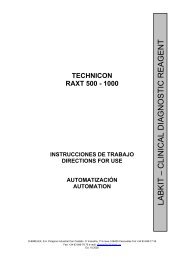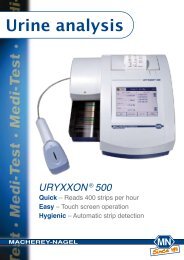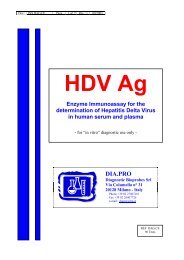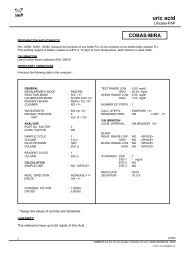Carbon Dioxide - Agentúra Harmony vos
Carbon Dioxide - Agentúra Harmony vos
Carbon Dioxide - Agentúra Harmony vos
Create successful ePaper yourself
Turn your PDF publications into a flip-book with our unique Google optimized e-Paper software.
CO2-LQ<br />
Presentation:<br />
2 x 50 mL. Ref.: 30430<br />
Store: 2 - 8 ºC.<br />
<strong>Carbon</strong> <strong>Dioxide</strong><br />
Liquid<br />
Quantitative determination of <strong>Carbon</strong> <strong>Dioxide</strong><br />
Only for in vitro use in clinical laboratory (IVD)<br />
TEST SUMMARY<br />
PEPC+Mg ++<br />
Phosphoenolpyruvate + HCO 3- -<br />
oxaloacetate + H 2 P0 4<br />
MDH<br />
oxaloacetate + NADH + H + malate + NAD +<br />
analogue analogue<br />
The reduction in absorbance at 415 nm caused by the oxidation of NADH<br />
analogue is proportional to the bicarbonate concentration in the sample.<br />
REAGENTS COMPOSITION<br />
R<br />
CAL<br />
FosfoenolpiruvatoPEP)<br />
NADH análogo<br />
PEPC<br />
MDH<br />
Tampón, pH 7.6<br />
Azida sódica 0.08%<br />
Liquid calibrator<br />
12.5 mmol/L<br />
0.66 mmol/L<br />
>400 U/L<br />
>4100 U/L<br />
REAGENT PREPARATION AND STABILITY<br />
Ready to use.<br />
All the components of the kit are stable until the expiration date on the label<br />
when stored tightly closed at 2-8ºC, protected from light and contaminations<br />
prevented during their use.<br />
Do not use reagents over the expiration date.<br />
All the reagents of the kit are stable up to the end of the indicated<br />
month and year of expiry. Store tightly closed at 2-8ºC. Do not use<br />
reagents over the expiration date.<br />
SPECIMEN<br />
We recommend LABKIT Liquid CO 2 -2 Calibrator. A 2 point calibration is<br />
recommended with every change of reagent lot/bottle.<br />
The LABKIT Liquid CO 2 -2 Calibrator is traceable to Sodium <strong>Carbon</strong>ate NIST<br />
reference material 351.<br />
SPECIMEN<br />
Serum or heparinized plasma.<br />
MATERIAL REQUIRED BUT NOT PROVIDED<br />
- Spectrophotometer or colorimeter measuring at 415 nm.<br />
- Matched cuvettes 1.0 cm light path.<br />
General laboratory equipment<br />
TEST PROCEDURE<br />
1. Assay conditions:<br />
Wavelength: . . . . . . . . . . . . . . . . . . . . . . 415 nm<br />
Cuvette: . . . . . . . . . . . . . . . . . . 1 cm. light path<br />
Temperature . . . . . . . . . . . . . . . . . 37ºC /15-25ºC<br />
2. Adjust the instrument to zero with distilled water.<br />
3. Pipette into a cuvette:<br />
Blank Calibrator Sample<br />
WR (mL) 1.0 1.0 1.0<br />
Calibrator (µL) -- 10 --<br />
Sample (µL) -- -- 10<br />
4. Mix and read the absorbance after 60 s (A 1 ) and 240 s (A 2 ).<br />
5. Calculate: ∆A= A 1 – A 2 .<br />
CALCULATIONS (Note 2)<br />
( ∆A)Sample<br />
x (Calibrator conc) = mmo/L CO 2 in the sample<br />
( ∆A)Calibrator<br />
QUALITY CONTROL<br />
Control sera are recommended to monitor the performance of the<br />
procedure, LABTROL H Normal Ref. 30950 and LABTROL H Pathological<br />
Ref. 30955. If control values are found outside the defined range, check<br />
the instrument, reagents and calibrator for problems.<br />
Serum controls are recommended for internal quality control. Each<br />
laboratory should establish its own Quality Control scheme and corrective<br />
actions.<br />
REFERENCE VALUES<br />
Adults: Arterial 21-28 mmol/L<br />
Venous 22-29 mmol/L<br />
Arterial: Newborn 17.2-23.6 mmol/L<br />
Infants 19.0-23.9 mmol/L<br />
It is suggested that each laboratory establish its own reference range.<br />
CLINICAL SIGNIFICANCE<br />
Increased blood CO 2 , (hypercapnia) causes respiratory acidosis, CO 2 rises<br />
with decreased alveolar ventilation due to diseases of the lungs or<br />
bronchial tree, or breathing CO 2 enriched air. Depression of the overall<br />
lung capacity by certain drugs may lead to retention of CO 2 .<br />
REAGENT PERFORMANCE<br />
1. Linearity: The method is linear up to a concentration of 45 mmol/L<br />
If the results obtained were greater than linearity limit, dilute the sample<br />
1/2 with NaCl 9 g/L and multiply the result by 2.<br />
2. Precision:<br />
Intra-assay(n=44) Inter-assay(n=44)<br />
Mean (mmol/L) 9.15 18.57 30.6 9.15 18.57 30.6<br />
SD 0.53 0.56 0.67 0.68 0.93 1.45<br />
CV (%) 5.8 3.0 2.2 7.4 5.0 4.7<br />
3. Sensitivity: The minimum detectable concentration of Total CO 2 with<br />
an acceptable level of precision was determined as 5 mmol/L.<br />
4. Accuracy: Results obtained using LABKIT reagents (y) did not show<br />
systematic differences when compared with other commercial reagent<br />
(x).<br />
The results obtained using 45 samples spanning the range 9.30 to<br />
42.57 mmol/L were the following:<br />
Correlation coefficient (r): 0.98.<br />
Regression equation y= 1.06x + 0.68.<br />
The results of the performance characteristics depend on the analyzer<br />
used.<br />
INTERFERING SUBSTANCES<br />
The main interference in this assay is CO 2 from the air or from the<br />
breath of the analyst. Some drugs and other substances are also<br />
known to influence blood CO 2 levels. Haemoglobin up to a<br />
concentration of 1000 mg/dl does not affect the assay.No conjugated<br />
bilirubin interference up to a concentration of 30 mg/dl.No free bilirubin<br />
interference up to a concentration of 60 mg/dl.No lipid interference (trigs<br />
and intralipid) up to a concentration of 1200 mg/dl.<br />
NOTES<br />
1. Do not expose reagent to the air longer than necessary and store<br />
tightly capped.<br />
2. Use clean disposable pipette tips for its dispensation.<br />
3. Do not shake reagent vigorously as this may cause excessive<br />
CO 2 absorption.<br />
4. CHEMELEX has instruction sheets for several automatic<br />
analyzers. Instructions for many of them are available on request.<br />
BIBLIOGRAPHY<br />
1. Tietz, N. N., et al "Textbook of Clinical Chemistry" W. B. Saunders Co.,<br />
1986; 1172-1253.<br />
2. Jacobs, N., et al "Laboratory Test Handbook" 2nd. ed., Williams and<br />
Wilkins 1990.<br />
3. Forrester, R.L., Wataji, L.J., Silverman, D.A., Pierre K.J., Clin, Chem.<br />
1976; 22/2: 243-245.<br />
4. Norris, K.A., Atkinson, A.R., Smith, W.G., Clin. Chem. 1975; 21/8: 1093 -<br />
1101.<br />
5. Young D.S., Effects of Drugs on Chemical Laboratory Tests, 3 rd ed.,<br />
AACC Press 1990.<br />
CHEMELEX, S.A.<br />
Pol. Ind. Can Castells. C / Industria 113, Nau J<br />
08420 Canovelles –BARCELONA- Tel- 34 93 849 17 35 Fax- 34 93 846 78 75<br />
LKBSIS80<br />
Ed. 2009
CO2-LQ<br />
Presentación:<br />
2 x 50 mL. Ref.: 30430<br />
Conservar entre: 2 - 8 ºC.<br />
Dióxido de <strong>Carbon</strong>o<br />
Líquido<br />
Determinación cuantitativa de Dióxido de <strong>Carbon</strong>o.<br />
Solo para uso in vitro en laboratorio clínico (IVD).<br />
PRINCIPIO<br />
PEPC+Mg ++<br />
Fosfoenolpiruvato + HCO 3- -<br />
oxaloacetato + H 2 P0 4<br />
MDH<br />
oxaloacetato + NADH + H + malate + NAD +<br />
análogo análogo<br />
La disminución de absorbancia a 415 nm causada por la oxidación de un<br />
análogo del NADH es proporcional a la concentración de bicarbonato en la<br />
muestra.<br />
COMPOSICIÓN DE LOS REACTIVOS<br />
R<br />
CAL<br />
FosfoenolpiruvatoPEP)<br />
NADH análogo<br />
PEPC<br />
MDH<br />
Tampón, pH 7.6<br />
Azida sódica 0.08%<br />
Calibrador líquido.<br />
12.5 mmol/L<br />
0.66 mmol/L<br />
>400 U/L<br />
>4100 U/L<br />
PREPARACIÓN DEL REACTIVO Y ESTABILIDAD<br />
Listo para su uso.<br />
Indicadores de deterioro de los reacti<strong>vos</strong>:<br />
- El reactivo precipitante puede presentar decoloración al contacto con la<br />
luz. Conservar al resguardo de la luz directa. Una ligera turbidez en el<br />
reactivo no afecta la determinación.<br />
Todos los reacti<strong>vos</strong> del kit son estables hasta el final del mes del año de<br />
caducidad indicado en la etiqueta. Con los frascos bien cerrados y<br />
conservado entre 2-8ºC. No usar el reactivo pasada su fecha de<br />
caducidad.<br />
CALIBRACIÓN<br />
Se recomienda usar el calibrador incluido en el kit. Se recomienda una<br />
calibración de 2 puntos siempre que se cambie el lote/frasco del reactivo. El<br />
calibrador líquido de CO 2 de LABKIT es trazable al Material de Referencia<br />
351 NIST.<br />
MUESTRAS<br />
- Suero o plasma heparinizado.<br />
MATERIAL NECESARIO NO INCLUIDO<br />
- Espectrofotómetro o analizador con cubeta para lecturas a 415 nm.<br />
- Cubetas de 1,0 cm. de paso de luz.<br />
Equipo general de laboratorio. (Nota 1, 2, 3) .<br />
PROCEDIMIENTO<br />
1. Condiciones del ensayo:<br />
Longitud de onda: . . . . . . . . . . . . . . . . . . . . . . 415 nm<br />
Cubeta:. . . . . . . . . . . . . . . . . . . . . . . 1 cm paso de luz<br />
Temperatura . . . . . . . . . . . . . . . . . . . . .37ºC /15-25ºC<br />
2. Ajustar el espectrofotómetro a cero frente a agua destilada.<br />
3. Pipetear en una cubeta:<br />
Blanco Calibrador Muestra<br />
RT (mL) 1,0 1,0 1,0<br />
Calibrador (µL) -- 10 --<br />
Muestra (µL) -- -- 10<br />
4. Mezclar. Leer las absorbancias a los 60 s (A 1 ) y a los 240 s (A 2 ).<br />
5. Calcular: ∆A= A 1 – A 2 .<br />
CÁLCULOS (Nota 2)<br />
( ∆A)Muestra<br />
x (Conc. Calibrador) = mmol/L de CO 2 en la muestra<br />
( ∆A)Calibrador<br />
CONTROL DE CALIDAD<br />
Es recomendable utilizar sueros de control, LABTROL H Normal Ref.<br />
30950 y LABTROL H Patológico Ref. 30955. Si los valores obtenidos<br />
están fuera de rango, se deben revisar los reacti<strong>vos</strong>, calibrador e<br />
instrumento utilizados.<br />
Los sueros de control son recomendables para los controles de calidad<br />
internos. Cada laboratorio debería establecer su propio esquema de<br />
calidad y acciones correctivas si los controles no cumplen con las<br />
tolerancias.<br />
VALORES DE REFERENCIA 1<br />
Adultos: Arterial 21-28 mmol/L<br />
Venoso 22-29 mmol/L<br />
Arterial: Bebés 17.2-23.6 mmol/L<br />
Niños 19.0-23.9 mmol/L<br />
Es recomendable que cada laboratorio establezca sus propios valores<br />
de referencia.<br />
SIGNIFICADO CLÍNICO<br />
El incremento de CO 2 en sangre (hipercapnia) causa acidosis respiratoria.<br />
El CO 2 aumenta por ventilación alveolar insuficiente debido a<br />
enfermedades de los pulmones o bronquios, o por respirar aire<br />
enriquecido en CO 2. Una depresión de la capacidad total del pulmón por<br />
ciertas drogas puede conducir a la retención de CO 2.<br />
CARACTERÍSTICAS DEL REACTIVO<br />
1. Linealidad: El método es lineal hasta concentraciones de 45 mmol/L<br />
Si la concentración de la muestra es superior al límite de linealidad,<br />
diluir 1/2 con agua destilada y multiplicar el resultado final por 2.<br />
2. Precisión:<br />
Intraserie (n=44) Interserie (n=44)<br />
Media (mmol/L) 9.15 18.57 30.6 9.15 18.57 30.6<br />
SD 0.53 0.56 0.67 0.68 0.93 1.45<br />
CV (%) 5.8 3.0 2.2 7.4 5.0 4.7<br />
3. Sensibilidad: La mínima concentración detectable de CO 2 total con<br />
un nivel de precisión aceptable, se determinó como 5 mmol/L<br />
Exactitud: Los reacti<strong>vos</strong> LABKIT no muestran diferencias sistemáticas<br />
significativas cuando se comparan con otros reacti<strong>vos</strong> comerciales.<br />
Los resultados obtenidos con 45 muestras de pacientes con<br />
concentraciones de 9.30 hasta 42.57 mmol/L fueron los siguientes:<br />
Coeficiente de regresión (r): 0,98.<br />
Ecuación de la recta de regresión: y= 1.06x + 0.68.<br />
Las características del método pueden variar dependiendo del<br />
instrumento utilizado.<br />
SUSTANCIAS QUE INTERFIEREN<br />
La principal interferencia en este ensayo es el CO 2 presente en el aire<br />
o de la respiración del analista. Algunas drogas y otras sustancias<br />
también pueden interferir. Hemoglobina hasta una concentración de<br />
1000 md/dL no interfiere. No hay interferencia de Bilirrubina conjugada<br />
hasta concentraciones de 30 mg/dL. No hay interferencia de Bilirrubina<br />
libre hasta concentraciones de 60 mg/dL. No hay interferencia de<br />
lípidos hasta concentraciones de 1200 mg/dL.<br />
NOTAS<br />
1. No exponer el reactivo al aire libre más tiempo del necesario y<br />
conservar bien cerrado.<br />
2. Usar puntas de pipeta desechables limpias para su<br />
dispensación.<br />
3. No agitar el reactivo con vigor ya que podría causar absorción<br />
excesiva de CO 2.<br />
4. CHEMELEX dispone de instrucciones detalladas para la<br />
aplicación de este reactivo en distintos analizadores.<br />
BIBLIOGRAFIA<br />
1. Tietz, N. N., et al "Textbook of Clinical Chemistry" W. B. Saunders Co.,<br />
1986; 1172-1253.<br />
2. Jacobs, N., et al "Laboratory Test Handbook" 2nd. ed., Williams and<br />
Wilkins 1990.<br />
3. Forrester, R.L., Wataji, L.J., Silverman, D.A., Pierre K.J., Clin, Chem.<br />
1976; 22/2: 243-245.<br />
4. Norris, K.A., Atkinson, A.R., Smith, W.G., Clin. Chem. 1975; 21/8: 1093 -<br />
1101.<br />
5. Young D.S., Effects of Drugs on Chemical Laboratory Tests, 3 rd ed.,<br />
AACC Press 1990.<br />
CHEMELEX, S.A.<br />
Pol. Ind. Can Castells. C / Industria 113, Nau J<br />
08420 Canovelles –BARCELONA- Tel- 34 93 849 17 35 Fax- 34 93 846 78 75<br />
LKBSIS80<br />
Ed. 2009


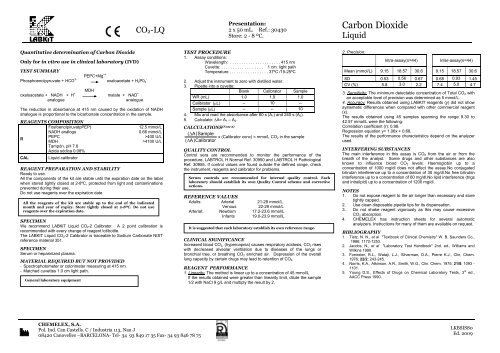
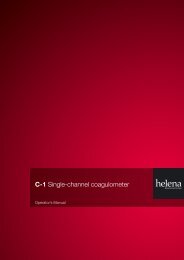
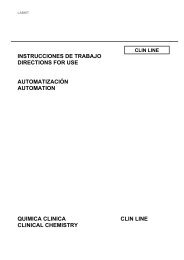
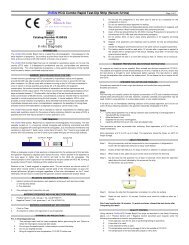
![[APTT-SiL Plus]. - Agentúra Harmony vos](https://img.yumpu.com/50471461/1/184x260/aptt-sil-plus-agentara-harmony-vos.jpg?quality=85)


![[SAS-1 urine analysis]. - Agentúra Harmony vos](https://img.yumpu.com/47529787/1/185x260/sas-1-urine-analysis-agentara-harmony-vos.jpg?quality=85)


![[SAS-MX Acid Hb]. - Agentúra Harmony vos](https://img.yumpu.com/46129828/1/185x260/sas-mx-acid-hb-agentara-harmony-vos.jpg?quality=85)

